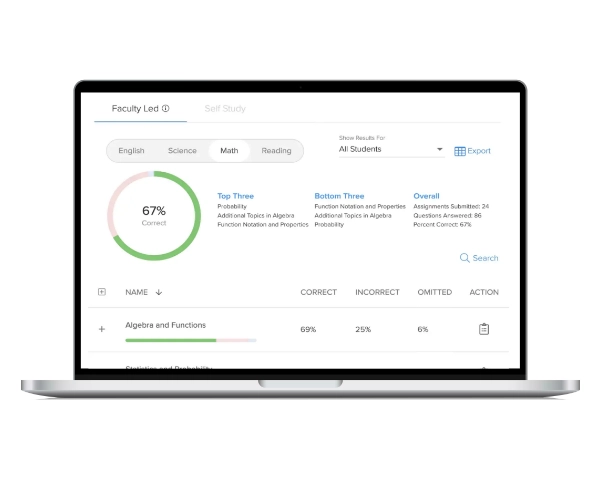The shift toward a Digital SAT® highlights the need to match testing with the advancements in technology that have transformed how we teach. The goal is to give students a test experience that reflects their everyday learning tools. For educators, this shift presents both challenges and opportunities. It’s up to school administrators to lead the way in navigating this change, making sure teachers are ready and students have the necessary digital literacy skills. By using effective Digital SAT strategies and promoting best practices for the exam in their schools, administrators can create a supportive environment that makes the transition to digital testing easier for everyone.
Understanding an Administrator’s Role in Digital SAT Preparation
In the era of Digital SAT preparation, high school administrators play an important and wide-ranging role in helping schools transition to digital readiness. They serve as motivators, resource providers, and strategists, all while fostering a culture of continuous learning and professional development. Their goal is to empower teachers with digital literacy and effective test preparation methods, ensuring that the shift toward digital does not compromise educational quality. To do this, administrators need to take a proactive approach to test prep by planning early and integrating digital resources into the curriculum. They also need to balance their responsibilities with direct support for educational processes, making sure that the technology infrastructure meets their school or district’s current needs and is adaptable for the future. By following the latest Digital SAT guidelines and creating a schoolwide culture of preparation and confidence, administrators not only navigate but also lead their schools through this transformative journey. In doing so, they can develop both teacher readiness and student success in a digital-first world.

Supporting teachers to foster student success
To support teachers in helping students succeed on the Digital SAT, it’s important to take a balanced approach that combines leadership and empowerment. As administrators, you can take the lead by organizing regular meetings to discuss progress, challenges, and SAT strategies for test preparation. This creates an open environment for communication and improvement. It’s also important to recognize and reward teachers who come up with innovative teaching practices. This not only motivates educators but also shows the value of creative approaches to digital test preparation. Providing effective professional development is essential. This can include workshops on digital literacy and the specifics of the Digital SAT platform, as well as sessions that help teachers seamlessly integrate SAT prep into their existing curriculums. Lastly, creating a collaborative environment is equally important. Setting up teacher-led forums and encouraging peer observations can provide invaluable opportunities for sharing best practices and refining Digital SAT strategies.
- Best Practices Resource 1: The DOE’s “Teacher Digital Learning Guide”1 is an excellent resource for administrators to provide professional development to educators. It equips teachers with effective strategies for digital education, helping them support their students’ success on the Digital SAT.
- Best Practices Resource 2: UWorld College Readiness solutions provide educators with instructional roadmaps that include pretests, pre-built assignments that align with existing Reading, Writing, and Math (Algebra I, Algebra II, and Geometry) courses, support guides, videos, and more. These extensive resources and practice tests for the Digital SAT fit in perfectly with existing course curriculum so teachers can easily integrate Digital SAT practice into their classes without getting their own subject requirements off-track. These resources provide a simple way administrators can fully support their teachers in delivering effective test preparation to students.
Implementing schoolwide support systems
Implementing schoolwide support systems for Digital SAT preparation is a strategy that requires careful integration of technology-based learning. To make it more engaging and effective for students, administrators can incorporate projects across subjects that use digital tools and platforms. This approach not only helps students understand the content better but also helps them become proficient in using the technology they will use on the actual SAT.
One of the best ways administrators can help familiarize students with the format and functionality of the Digital SAT is by providing their school with online practice tests and questions that simulate those on the exam. Online tools and resources like UWorld, which closely resemble the real Digital SAT, give students a realistic practice experience. UWorld’s pre-built Digital SAT assignments provide support systems for teachers who need a simple way to integrate SAT prep into their daily instruction without additional planning and without sacrificing the time needed for their regular coursework. An Algebra II teacher, for example, can assign an algebra-centered study guide with a pretest, along with pre-built assignment questions that match the level of their students.
Additionally, administrators can support teachers by establishing a structured timetable for regular Digital SAT practice sessions, followed by feedback sessions to address areas of improvement, reinforcing a cycle of continuous learning and adaptation that is essential for student success in a digital testing landscape.
- Best Practices Resource 1: The DOE’s “School Leader Digital Learning Guide”2 equips administrators with valuable insights and practical tools to create comprehensive support systems in their schools. This guide aims to improve the digital SAT preparation process for students at all levels of education.
- Best Practices Resource 2: UWorld’s Online Preparation for the Digital SAT provides real-time and accurate data on a class, campus, and district level. This information is invaluable for administrators as it helps them ensure compliance with Digital SAT guidelines. Not only that, but it also enables administrators to effectively support their staff in test preparation efforts.
Ensuring adherence to digital SAT guidelines and logistics
When it comes to administering the Digital SAT, educators play a vital role in understanding and managing the process. It’s important for administrators to become familiar with the SAT’s technical requirements set by the College Board® and to stay updated on any changes. To make sure everything goes smoothly, administrators need to create a comprehensive checklist that covers all the necessary technological and logistical aspects of the Digital SAT. This means making sure there’s a reliable internet connection in the testing environment and having protocols in place to address any technical issues that may come up. But it’s not just about the technical stuff – administrators also need to focus on the people involved. Training sessions are imperative to familiarize staff with the digital platform and ensure everyone understands the compliance requirements. By being well-prepared, administrators can make sure they follow the guidelines set by the College Board and that students have a stress-free Digital SAT testing experience.
- Best Practices Resource 1: By keeping up-to-date with the College Board’s official Digital SAT guidelines, “An Educator’s Guide to the Digital SAT,”3 administrators can make sure their school meets the test’s requirements and ensures a smooth and efficient test administration process.
- Best Practices Resource 2: UWorld’s Online Preparation for the Digital SAT provides administrators with extremely helpful insights by giving them real-time and accurate data on a class, campus, and district level. This empowers administrators to easily follow Digital SAT guidelines and effectively support their staff in test preparation.
Building a culture of preparation and confidence
Building a culture of preparation and confidence within a school is a transformative process that requires administrators to champion values of resilience, adaptability, and proactive preparation. Launching initiatives that celebrate both small milestones and significant progress in Digital SAT prep are a great way to foster this culture. It’s also important to directly address and reduce test anxiety by using strategies that boost student confidence. An essential part of this process is using student feedback and performance data to personalize learning and preparation strategies according to individual needs. Encouraging student-led review sessions can create an environment of peer support and collaborative learning. Additionally, it is important to cultivate a growth mindset among students and staff, emphasizing the significance of continuous improvement and learning from challenges. Sharing stories of resilience and success in digital learning environments not only inspires, but also reinforces the belief in every student’s ability to overcome obstacles and succeed in the Digital SAT landscape.
- Best Practices Resource 1: UWorld’s blog post, “10 Ways Intrinsic Motivation Drives Learning and Helps High School Students Take Ownership,” provides administrators with actionable strategies to foster a school culture of preparation and confidence by empowering students to take control of their learning journey.
- Best Practices Resource 2: Eastern Washington University’s article, “How Principals Can Create a Positive School Culture,”4 provides valuable insights for educators on how to shape a supportive educational environment. This is pivotal in building confidence and preparing students and staff to effectively tackle the Digital SAT.
Student-Centric Approaches
In the switch to a digital, adaptive SAT, high school admins are tackling the challenge of finding study methods that match the test’s personalized approach. This change highlights the importance of educational tactics that cater to each student’s unique needs, ensuring everyone gets the help they need to succeed.
A student-focused strategy relies on making custom learning paths that adjust to each student’s requirements. By using data analytics, teachers can spot where students excel or struggle, allowing for a more precise and efficient study plan. UWorld helps out by offering a variety of customizable practice questions and detailed feedback, making it easier for educators to adjust their teaching and concentrate on areas that will have the biggest impact on student progress.
Future-Proofing SAT Preparation
As we navigate the transition toward a digital-first SAT, the onus falls on high school administrators to not only anticipate but actively prepare for the future of standardized testing. This preparation extends beyond a familiarity with digital platforms to embedding these technologies within Digital SAT preparation. As the SAT continues to evolve within its digital form, it signifies a shift that many other standardized tests are sure to follow.
- Innovations in Digital Education and Testing: In this era of rapid technological evolution, administrators have a unique opportunity to revolutionize SAT preparation at their schools. By integrating emerging technologies into campus resources and expectations, administrators can create a more dynamic and engaging learning environment that mirrors the digital realities students face every day. This shift is not just about navigating the SAT; it’s about empowering our students with essential digital literacy skills that will serve them well into the future. An administrator’s preparation strategies at a campus-level will ensure their schools’ students are not just prepared but are ahead of the curve.
- Sustainable Practices for Long-Term Success: Establishing a sustainable model for SAT preparation requires administrators to build school systems that are both scalable and adaptable, catering to the diverse needs of their student body. Making sure all students have access to necessary digital tools and resources is imperative for creating a level playing field. By focusing on developing scalable, flexible, and equitable preparation models, administrators can lay the groundwork for not only Digital SAT excellence but also for a more inclusive digital testing landscape.
Key Takeaways
When navigating the transition to the Digital SAT, the role of administrators is paramount, serving not just as leaders but as catalysts for change and innovation within their schools. To make this shift successful, visionary leadership and strategic planning are essential. We need to take a holistic and innovative approach to test preparation. This means championing practices that promote continuous improvement and adaptability to digital learning. By doing so, administrators can create a supportive and collaborative educational community. This journey towards digital readiness is an opportunity to redefine success on the SAT. With resources like UWorld’s Online Preparation for the Digital SAT, administrators have the tools they need to ensure their students are well-prepared for exam day. Let’s set a new standard for excellence in education.

References
- Office of Educational Technology. (n.d.). Teacher digital learning guide. U.S. Department of Education. Retrieved February 7, 2024, from https://tech.ed.gov/publications/digital-learning-guide/teacher/
- Office of Educational Technology. (n.d.). School leader digital learning guide. U.S. Department of Education. Retrieved February 7, 2024, from https://tech.ed.gov/publications/digital-learning-guide/school-leader/
- UWorld. (n.d.). Digital SAT. Retrieved February 7, 2024, from https://collegeprep.uworld.com/sat/digital-sat/
- Eastern Washington University. (n.d.). How principals can create a positive school culture. Retrieved February 7, 2024, from https://online.ewu.edu/degrees/education/med/educational-leadership/create-a-positive-school-culture/
- ScholarWorks. (n.d.). [Title of Dissertation]. Walden University. Retrieved February 7, 2024, from https://scholarworks.waldenu.edu/cgi/viewcontent.cgi?article=3284&context=dissertations Note: Replace [Title of Dissertation] with the actual title of the dissertation, which wasn’t provided.
- WeAreTeachers. (n.d.). How to get teachers onboard with standardized testing. Retrieved February 7, 2024, from https://www.weareteachers.com/teachers-onboard-standardized-testing/
- Nearpod. (n.d.). Schoolwide standardized test prep strategies for administrators. Retrieved February 7, 2024, from https://nearpod.com/blog/schoolwide-standardized-test-prep-strategies-for-administrators/
- Caveon Test Security. (n.d.). Test administration guidelines. Retrieved February 7, 2024, from https://blog.caveon.com/test-administration-guidelines
- JSTOR. (n.d.). [Title of Article]. [Journal Name], [Volume(Issue)], [Page Numbers]. Retrieved February 7, 2024, from https://www.jstor.org/stable/20386058 Note: Replace [Title of Article], [Journal Name], [Volume(Issue)], and [Page Numbers] with the actual details, which weren’t provided.
- College Board. (n.d.). Helping students practice for the SAT. Retrieved February 7, 2024, from https://satsuite.collegeboard.org/sat/practice-preparation/helping-students




